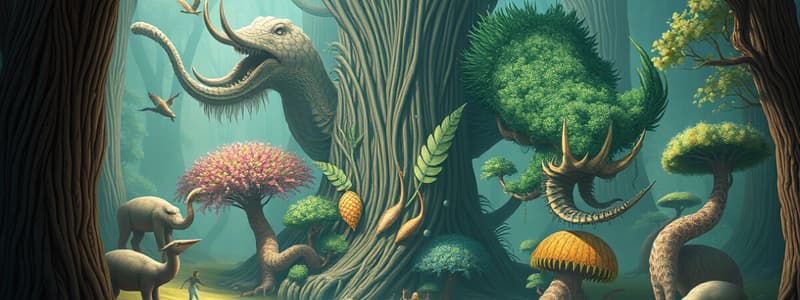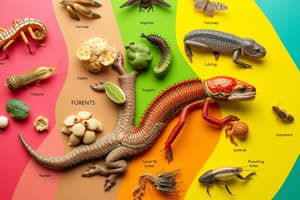Podcast
Questions and Answers
Which of these options are one of the five kingdoms of living things?
Which of these options are one of the five kingdoms of living things?
- Animals (correct)
- Humanoid
- Fungi (correct)
- Humans
The first big division of living things in the classification system is to put them into one of five __________.
The first big division of living things in the classification system is to put them into one of five __________.
kingdoms
What is the primary rank in the classification system?
What is the primary rank in the classification system?
kingdom
Match the following arthropod groups with their leg counts:
Match the following arthropod groups with their leg counts:
A species is defined as a group of organisms that can interbreed to produce fertile offspring.
A species is defined as a group of organisms that can interbreed to produce fertile offspring.
What is the scientific name for human beings?
What is the scientific name for human beings?
Similar species tend to live in similar __________.
Similar species tend to live in similar __________.
What is one challenge of classifying organisms into species?
What is one challenge of classifying organisms into species?
What does the binomial system use to name species?
What does the binomial system use to name species?
Study Notes
Kingdoms
- Organisms are classified into five kingdoms based on cellular characteristics.
- Five Kingdoms:
- Animalia: All multicellular animals, including jellyfish, worms, fish, and mammals.
- Plantae: All green plants, including non-seeding ferns and mosses, as well as seeding conifers and flowering plants.
- Fungi: Includes moulds, mushrooms, and yeast.
- Protoctista: Comprises simple organisms including bacteria and blue-green algae.
- Prokaryotes: Single-celled organisms like Amoeba and Paramecium.
Classification
- The classification system ranks organisms, starting with kingdoms.
- Hierarchy of Classification:
- Kingdom
- Phylum
- Class
- Order
- Family
- Genus
- Species
- Example: Lion's classification:
- Kingdom: Animal
- Phylum: Vertebrate
- Class: Mammal
- Order: Carnivorous
- Family: Cat
- Genus: Big Cat
- Species: Lion
- Mnemonic for classification: "Kevin plays clarinet or flute - grotty sound!"
Arthropods
- Arthropods are vital invertebrates without backbones.
- Classifications within arthropods based on leg count:
- Insects: 6 legs
- Arachnids: 8 legs
- Crustaceans: 10 to 14 legs
- Myriapods: More than 20 legs, includes centipedes and millipedes.
Higher Tier
- Classification systems may be artificial, based on observable features.
- Biologists utilize field guides for organism identification.
- Natural classification systems, informed by DNA, better reflect evolutionary relationships.
- Modern techniques allow for easy DNA sequencing and comparisons, facilitating the creation of evolutionary trees.
Species
- A species consists of organisms that can interbreed and produce fertile offspring.
- Individuals within a species share more characteristics with each other than with those of different species.
- Species may exhibit variation through different breeds or types.
Species and Habitats
- Similar species generally inhabit similar environments.
- Closely related species share a common ancestor and may adapt differently based on habitat.
Binomial System
- Proposed by Carl Linnaeus in the 18th century to classify species using scientific names.
- Each species is named using Latin, providing universal identification.
- Naming structure: Genus (first part) + Species (second part), e.g., humans are classified as Homo sapiens.
Classification Challenges
- Some organisms present classification difficulties due to ongoing evolution.
- Asexual reproduction complicates species classification.
- Hybrid species, like the liger (lion-tiger cross), blur traditional species definitions.
Studying That Suits You
Use AI to generate personalized quizzes and flashcards to suit your learning preferences.
Description
Explore the five kingdoms of living organisms, which categorize life based on shared characteristics and cellular structures. This quiz will enhance your understanding of the diversity in the biological world, including animals and plants.




